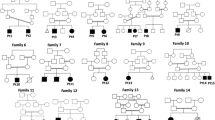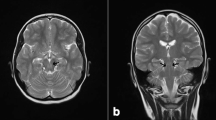Abstract
The peroxisomal biogenesis disorders (PBDs) comprise the Zellweger spectrum disorders (i.e., Zellweger syndrome, neonatal adrenoleukodystrophy, and infantile Refsum disease) and rhizomelic chondrodysplasia punctata. Peroxisomal biogenesis disorders can be caused by mutations in any of 13 currently known PEX genes, which encode peroxins involved in peroxisomal protein import and/or assembly of the organelle. We report here on a Turkish patient who presented with unusual clinical findings, that included non-immune hydrops, dermal erythropoiesis and hypoplastic toenails, as well as common dysmorphic features of Zellweger syndrome. The patient has also pulmonary hypoplasia, which has been reported in only a few patients with Zellweger syndrome. A peroxisomal biogenesis disorder was confirmed by enzyme analysis and abnormal very long-chain fatty acid (VLCFA) profiles in plasma and fibroblast and immunofluorescence microscopy studies. Subsequent molecular genetic analysis revealed a homozygous c.856C>T mutation (R268X) in the PEX3 gene, which made this patient the third to have a defect in this gene. In contrast to those of the two previously reported patients, the cells of this patient still contained peroxisomal membrane structures (ghosts), seen by immunofluorescence microscopy analysis. The case presented here and the two previously reported cases point out that a PEX3 gene defect may present with fairly heterogeneous clinical findings. This case also raises a possibility that hydrops fetalis may be associated with a PEX3 gene defect and that peroxisomal disorders can be considered in the etiology of hydrops fetalis as well as other cell organelle disorders when one is considering yet undiscovered complementation groups in peroxisomal disorders.


Similar content being viewed by others
References
Burin MG, Scholz AP, Gus Ret al R (2004) Investigation of lysosomal storage diseases in nonimmune hydrops fetalis. Prenat Diagn 24:653–657
Ghaedi K, Honsho M, Shimozawa N et al (2000) PEX3 is the causal gene responsible for peroxisome membrane assembly-defective Zellweger syndrome of complementation group G. Am J Hum Genet 67:976–981
Gilchrist KW, Gilbert EF, Goldfarb Set al (1976) Studies of malformation syndromes of man XIB: the cerebro-hepato-renal syndrome of Zellweger: comparative pathology. Eur J Pediatr 121:99–118
Meulemans A, Seneca S, Smet J et al (2007) A new family with the mitochondrial tRNAGLU gene mutation m.14709T>C presenting with hydrops fetalis. Eur J Paediatr Neurol 11:17–20
Muntau AC, Mayerhofer PU, Paton BC et al (2000) Defective peroxisome membrane synthesis due to mutations in human PEX3 causes Zellweger syndrome, complementation group G. Am J Hum Genet 67:967–975
Poulos A, Christodoulou J, Chow CW et al (1995) Peroxisomal assembly defects: clinical, pathologic, and biochemical findings in two patients in a newly identified complementation group. J Pediatr 127:596–599
Prendville JS (2006) Cutaneous structures. In: Stevenson RE, Hall JG, eds; Sulik KK, Gilbert-Barness E, Buchahan KK, assoc. eds. Human malformations and related anomalies, 2nd edn. Oxford University Press, New York, 1336–1337
Schwarz M, Thiel C, Lübbehusen J et al (2004) Deficiency of GDP-Man:GlcNAc2-PP-dolichol mannosyltransferase causes congenital disorder of glycosylation type Ik. Am J Hum Genet 74:472–481
Shimozawa N, Suzuki Y, Zhang Z et al (2000) Identification of PEX3 as the gene mutated in a Zellweger syndrome patient lacking peroxisomal remnant structures. Hum Mol Genet 9:1995–1999
Smets K, Van Aken S (1998) Fetomaternal hemorrhage and prenatal intracranial bleeding: two more causes of blueberry muffin baby. Eur J Pediatr 157:932–934
Sosa ME (1999) Nonimmune hydrops fetalis. J Perinat Neonatal Nurs 13:33–44
Stephenson T, Zuccollo J, Mohajer M (1994) Diagnosis and management of non-immune hydrops in the newborn. Arch Dis Child 70:F151–F154
Acknowledegments
The authors thank Mrs. Conny Dekker and Mrs. Petra Mooyer of the Laboratory of Genetic Metabolic Diseases, Amsterdam, The Netherlands, for performing the enzyme assays for DHAPAT and the immunofluorescence study to demonstrate peroxisomes in fibroblast culture. This study was supported partly by a State Planning organization (project no. 2006K120-640-06-03)
Author information
Authors and Affiliations
Corresponding author
Additional information
Communicated by: Guy Besley
Rights and permissions
About this article
Cite this article
Dursun, A., Gucer, S., Ebberink, M.S. et al. Zellweger syndrome with unusual findings: non-immune hydrops fetalis, dermal erythropoiesis and hypoplastic toe nails. J Inherit Metab Dis 32 (Suppl 1), 345–348 (2009). https://doi.org/10.1007/s10545-009-9010-0
Received:
Revised:
Accepted:
Published:
Issue Date:
DOI: https://doi.org/10.1007/s10545-009-9010-0




